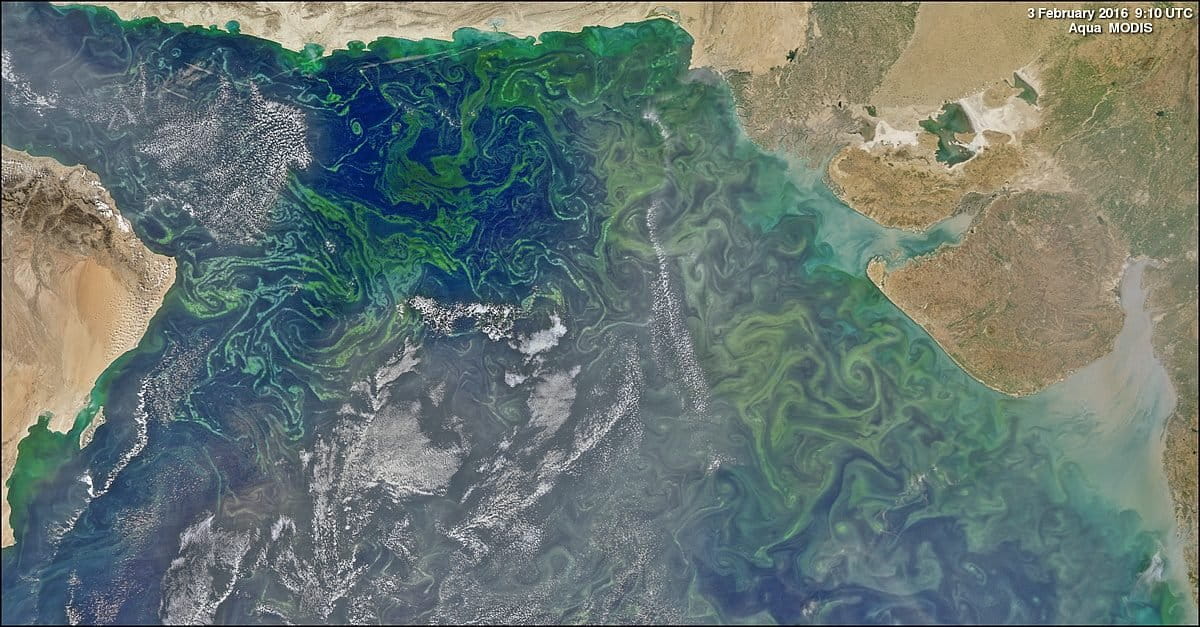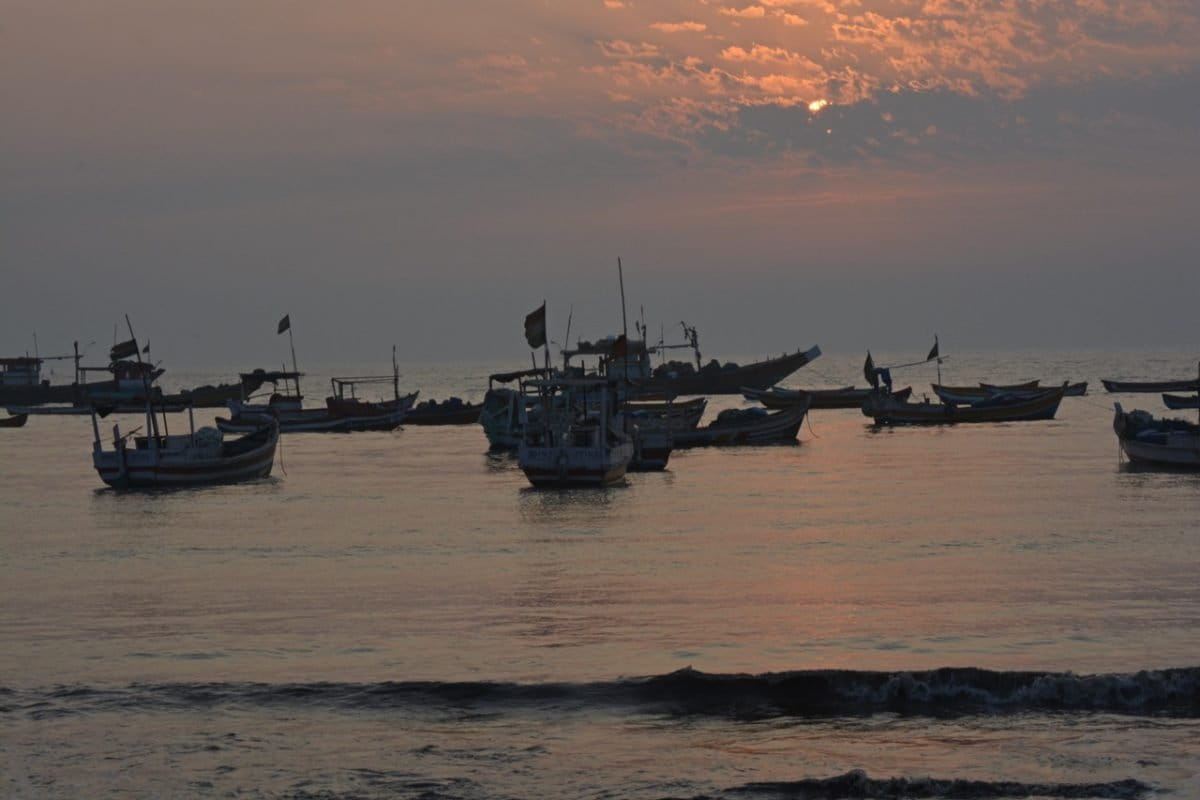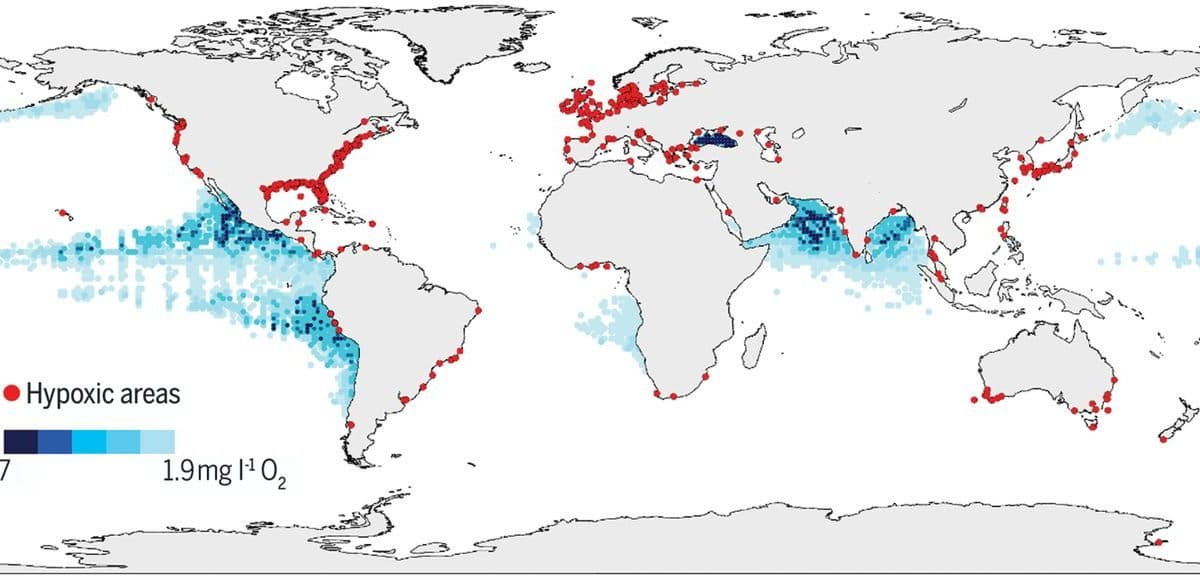- Open oceans and coastal sites are losing more oxygen and low-oxygen zones are spreading due to rising ocean temperatures and nutrient pollution from fertilizers and human sewage.
- Low oxygen levels can kill fish or reduce their growth and reproductive abilities. Though in the short term, fisheries could benefit as fish congregate in well-oxygenated waters, but in the long term this can lead to overfishing.
- Massive algal blooms can disrupt the food chain affecting fish stocks and they can also produce toxins.
- Improving sanitation and reducing excessive fertilizer use can halt the decline in oxygen as well as reining in on greenhouse gas emissions.
In March 2017, an area in the western Arabian Sea off the coast of Oman – equivalent to the size of Mexico – was blanketed with green swirls extending down to India. It was a striking scene, visible from space. The slimy green mass in this outbreak was Noctiluca scintillans, a single-celled dinoflallegate, which “short-circuited” the marine food chain.
Normally, this species is not seen here but over the past two decades this winter bloom has become a regular phenomenon triggered by low-oxygen waters—dubbed as ‘dead zones.’ A new review study notes that these zones are growing in area globally, as the oceans and seas – including the Arabian Sea and the Bay of Bengal – are losing more oxygen and endangering marine life. In the open ocean, 2 percent of oxygen has been lost over the past 50 years and coastal dead zones have shot up more than tenfold since 1950, thanks to climate change and increasing nutrient pollution.

Why does this happen?
In the Arabian Sea and the Bay of Bengal, there are two types of dead zones. In the open ocean, these zones are naturally present, known as oxygen-minimum zones (OMZs), ranging in depth from the upper layers (100-150m) to the lower boundaries (400-1000m), and arise mainly from poor vertical mixing, explains S.W.A. Naqvi, a scientist and co-author of the paper, and formerly the director of the National Institute of Oceanography.
In shallower coastal waters, seasonal dead zones form when the summer southwest monsoon winds churn up deep nutrient-rich, oxygen-poor waters to the surface—a process known as upwelling. The surge in nutrients spurs the growth of phytoplankton, microscopic photosynthetic algae at the base of the marine food chain, as seen in blooms.
More snowmelt in the Himalayas has resulted in warmer land temperatures that have strengthened the summer monsoon winds. This leads to more intense upwelling in the western Arabian Sea, stimulating phytoplankton blooms in larger areas along the coastal waters of Somalia, Oman, and Yemen. Towards the end of the season when the phytoplankton dies and sinks, microorganisms that decompose them drain oxygen from the waters. In the long term, this can expand the natural OMZs both in area and in depth.

Warmer waters, increasing sewage inflow
Another culprit: rising ocean temperatures. Oxygen is less soluble in warmer waters, which accounts for a 15% drop in total global loss of oxygen in the upper 1000 m of the ocean. The remaining loss may be because of warmer, less dense surface layers reducing the transport of surface oxygenated water into the ocean’s interior. Also, the metabolic rate of organisms is higher in warmer waters, increasing their demand for oxygen.
Besides, exploding population growth in cities such as Karachi and Mumbai means the coasts are bombarded with unprecedented levels of nitrogen and phosphorus discharged from agricultural runoff and human sewage on a daily basis. In the monsoon season, more fertilizers are washed into the Arabian Sea.
During the summer months, severe oxygen consumption in the Arabian Sea makes it the largest dead zone by area in the world, says Naqvi. “Winter blooms of Noctiluca are increasing annually with their extent more southerly than in the past,” observes, Helga do Rosario Gomes, a biological oceanographer at the Lamont-Doherty Earth Observatory at Columbia University, although there is no published data.

Effects of low-oxygen zones on marine life
Bottom-sea fish have evolved adaptations to low-oxygen, but when levels drop too low, they can suffocate and die. Even short-lived oxygen deprivation can stunt the growth of marine animals, impair reproduction, and increase susceptibility to disease.
While growth of phytoplankton means more food for fish, and fisheries may benefit from a higher concentration of bottom-sea fish in a confined area as they escape from the dead zones, over time this may lead to overfishing and is unsustainable.
If the already low oxygen levels on India’s west coast fall further, fisheries can be negatively impacted, says Naqvi. Fish can suffocate and die. In 2001, oxygen levels plunged substantially in the west coast and he found that landing of fish from the bottom of the sea had fallen drastically.
Blooms of unusual phytoplankton can adversely impact the food chain affecting fisheries. Noctiluca has been able to thrive in the low-oxygen waters because it has a dual-feeding advantage over the diatoms that originally formed the base of the food chain, explains Gomes. Not only does it voraciously consume other smaller phytoplankton, says Gomes, it also gets food from large populations of photosynthesizing organisms living inside it that are more efficient at fixing carbon in low oxygen than other phytoplankton.

What’s concerning is that only jellyfish, salps, and turtles prefer to eat Noctiluca but larger organisms do not have a taste for these, reducing their food availability. This may harm fisheries affecting 120 million people living on the coasts of the Arabian Sea.
Another issue is that some harmful algae produce toxins that can accumulate in marine life. “The most recent threat to fisheries on the west coast of India is ciguatoxins” caused by “algae associated with coral reefs and hence this problem applies to fish caught outside the immediate coastal zone,” says Anna Godhe, a marine ecologist at the University of Gothenburg in Sweden. She points out that in October 2016, more than 100 people in Mangaluru fell ill after consuming kingfish and snapper.
Halting oxygen decline
Tackling the main causes such as reducing greenhouse gas emissions and nutrient discharges per person will be the key. In addition, establishing marine protected areas in well-oxygenated areas used by fish can protect their populations.

Greater investment in sewage treatment facilities by coastal cities in the Arabian Sea will reduce much of the raw sewage dumped into the sea. Also, India needs more effective management of fertilizer application on crops, says Naqvi. Fertilizer consumption more than doubled from 1990 to 2015. He notes that “application of fertilizers by farmers may sometimes not be need-based” and stresses the importance of educating farmers on the optimal use of fertilisers including the harmful effects of overuse.
Greater monitoring of oxygen levels with real-time data will reveal which regions in the world are most vulnerable to low-oxygen and enable rapid intervention.
CITATION:
Breitburg et al. (2018). Declining oxygen in the global ocean and coastal waters. Science 359, 46, doi: 10.1126/science.aam7240
Gomes, H. d. R., Goes, J., Matondkar, S. G. P., Buskey, E. J., Basu, S., Parab, S., and Thoppil, P. (2014). Massive outbreaks of Noctiluca scintillans blooms in the Arabian Sea due to spread of hypoxia. Nature Communications 5: 4862, doi:10.1038/ncomms5862
Lachkar, Z., Lévy, M., and Smith, S. (2018). Intensification and deepening of the Arabian Sea oxygen minimum zone in response to increase in Indian monsoon wind intensity, Biogeosciences, 15, 159-186, doi.org/10.5194/bg-15-159-2018
Naqvi et al. (2009). Seasonal Anoxia Over the Western Indian Continental Shelf, in Indian Ocean Biogeochemical Processes and Ecological Variability (eds J. D. Wiggert, R. R. Hood, S.Wajih. A. Naqvi, K. H. Brink and S. L. Smith), American Geophysical Union, Washington, D.C., doi: 10.1029/2008GM000745